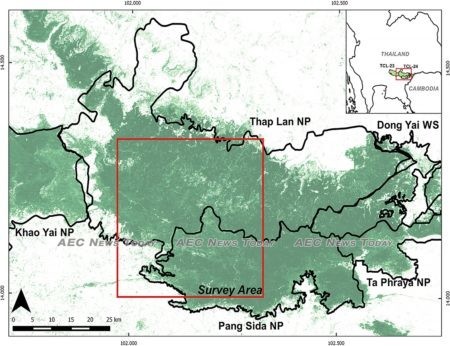There is renewed hope for Asia’s wild tiger population with images from camera traps similar to those captured in the video above recording showing tiger cubs in Thailand’s Dong Phayayen-Khao Yai (DPKY) forest.

Published in Biological Conservation, the survey has provided conservationists and authorities with hope that the decade-old DPKY Tiger Recovery Project (TRP) may meet its goal of increasing the local tiger population by 50 per cent by 2026.
It is currently believed that there are only 221 Indochinese tigers in Asean — in Thailand and Myanmar — with local populations in Lao PDR, Vietnam, and Cambodia believed to already be extinct.
According to the researchers, the population density in the area of the study is only 0.63 tigers per 100 square kilometres (about 39 sq.miles) — much lower than other habitats.
A previous study in Thailand’s Western Forest Complex (WEFCOM) in Huai Kha Khaeng between 2005 and 2012 estimated a density ranging from 1.27 to 2.09 tigers per 100 kilometres.
While differences in study methodology makes exact comparisons difficult, there is at least suggestion of an improvement in the DPKY population.
Monitoring crucial to preventing local extinctions

For this study the researchers said they used a spatially explicit capture-recapture (SECR) analysis. Yet, with few tigers out there, reliable results were difficult.
In this situation, they said simulations and the use of non-regular trap arrays may be beneficial.
Lead author of the study and a researcher with WildCRU, Eric Ash, said that to avoid local extinctions similar to those in Laos and Cambodia “monitoring is critical for managers to evaluate populations over time and determine the efficacy of conservation actions.
“It can also determine areas of conservation priority in which protection efforts can be focused”.
Classified as endangered on the IUCN Red List, Thailand’s tigers are under increasing pressure from agricultural reclamation, illegal logging, and poaching for tiger parts.
Wild tigers population have declined from some 100,000 a century ago to around 3,900 today, most of which are found in India. Captive tigers in the USA today outnumber those in the wild globally.
Feature video Freeland Foundation
Feature photo Freeland Foundation
Related:
- Thailand is seeking to save its last few wild tigers (Sustainability Times)
- Saving the Indochinese tiger (The ASEAN Post)
- New study confirms the importance of tiger population in Thailand forest complex (Phys.org)
- Photos of wild tiger cubs in Thailand rekindles hope for species (Mongabay)
Justhine De Guzman Uy
After graduation she worked at the Philippine Broadcasting Service performing transcription and business news writing, before moving to Eagle Broadcasting Corporation where she worked as a news editor, translator and production assistant.
Latest posts by Justhine De Guzman Uy (see all)
- Fintech startup to provide greater financial inclusion for Malaysia’s migrant workers – July 25, 2020
- Indonesia morning news for July 24 – July 24, 2020
- Singapore morning news for July 24 – July 24, 2020
- Indonesia morning news for July 23 – July 23, 2020

